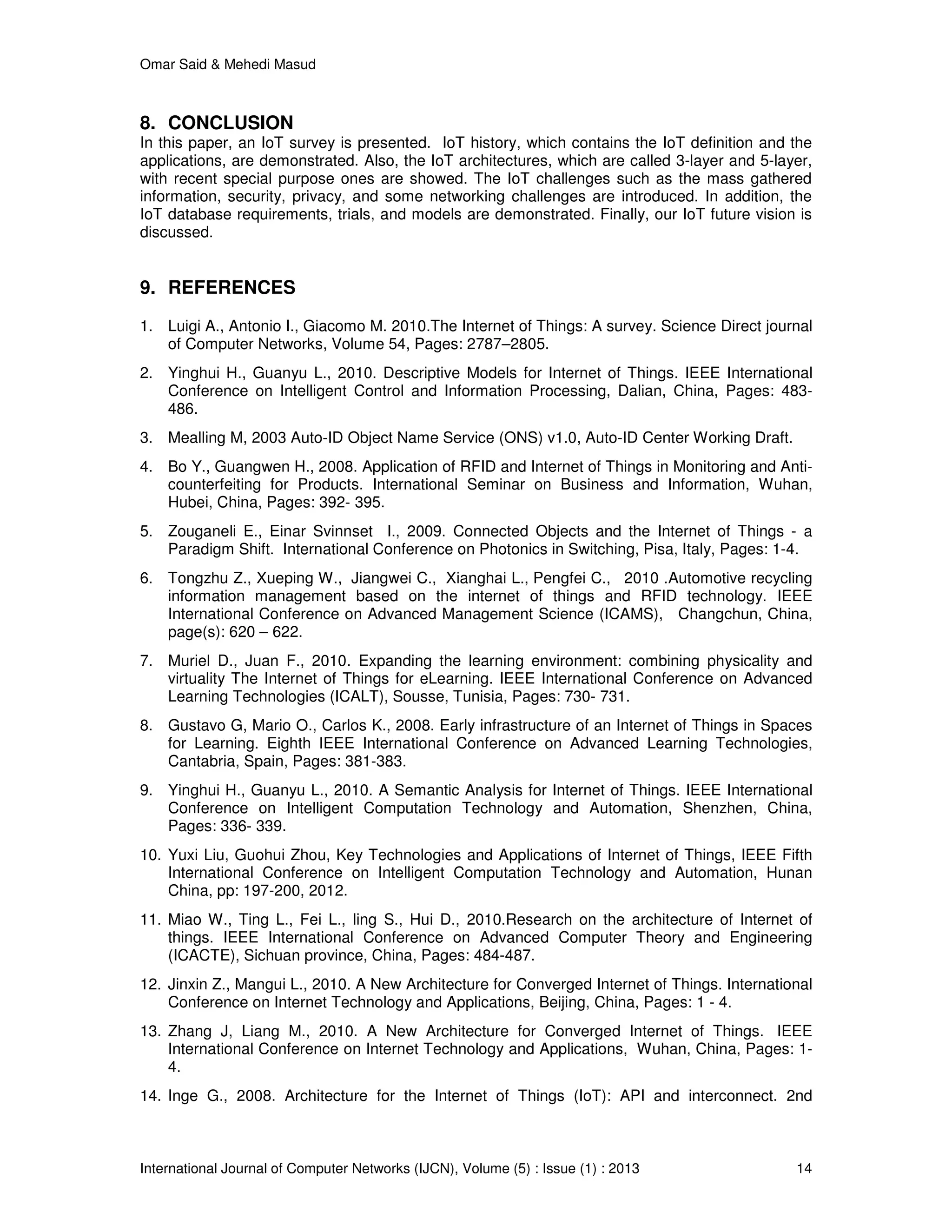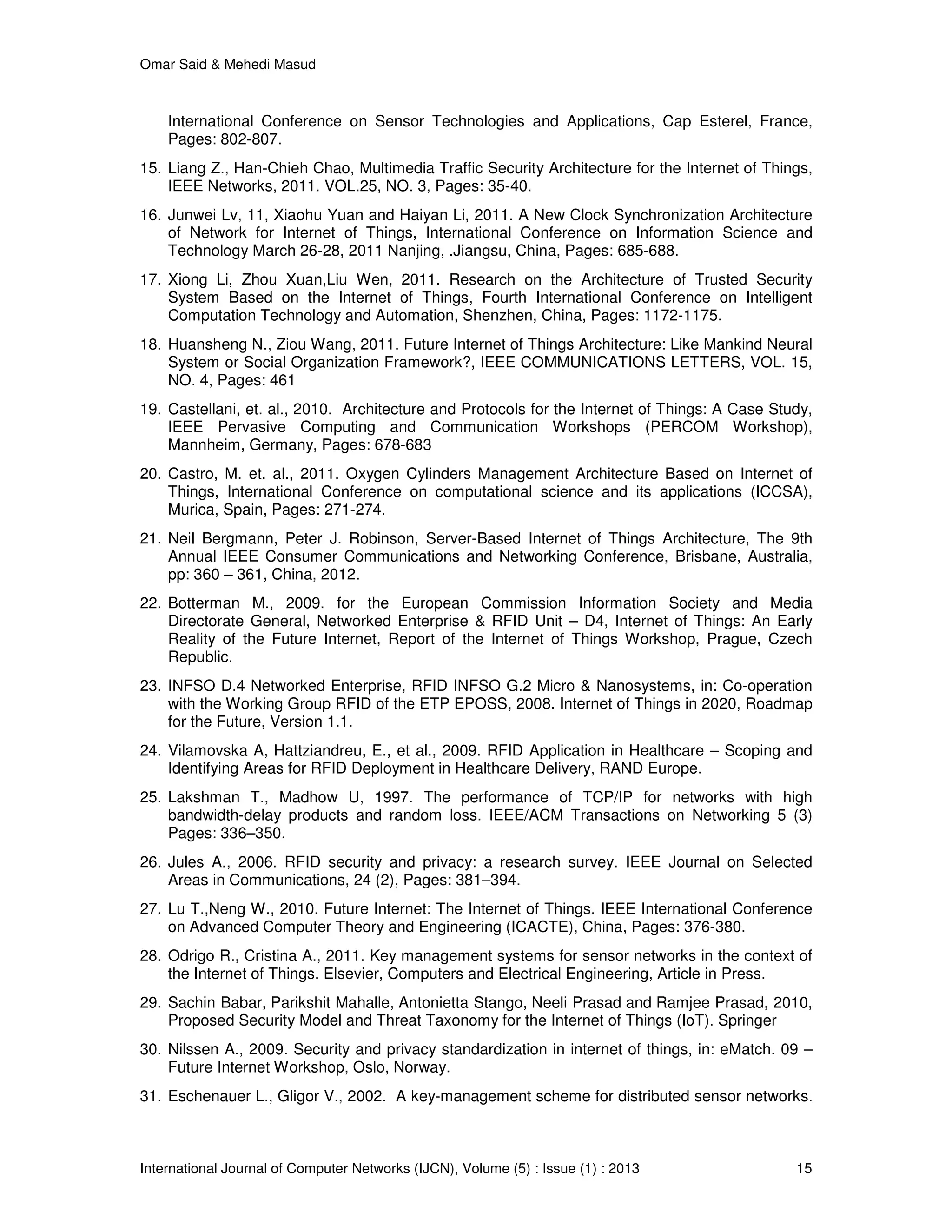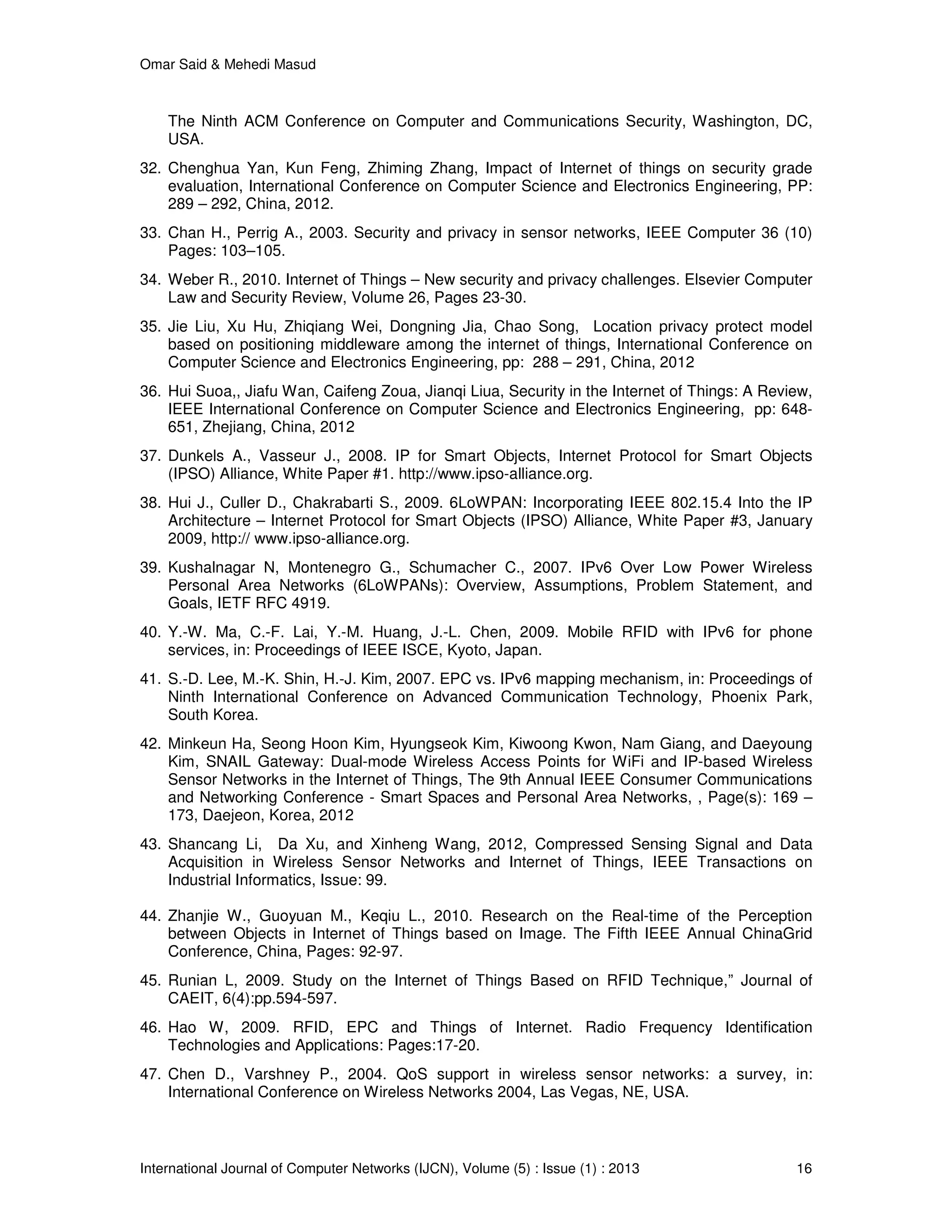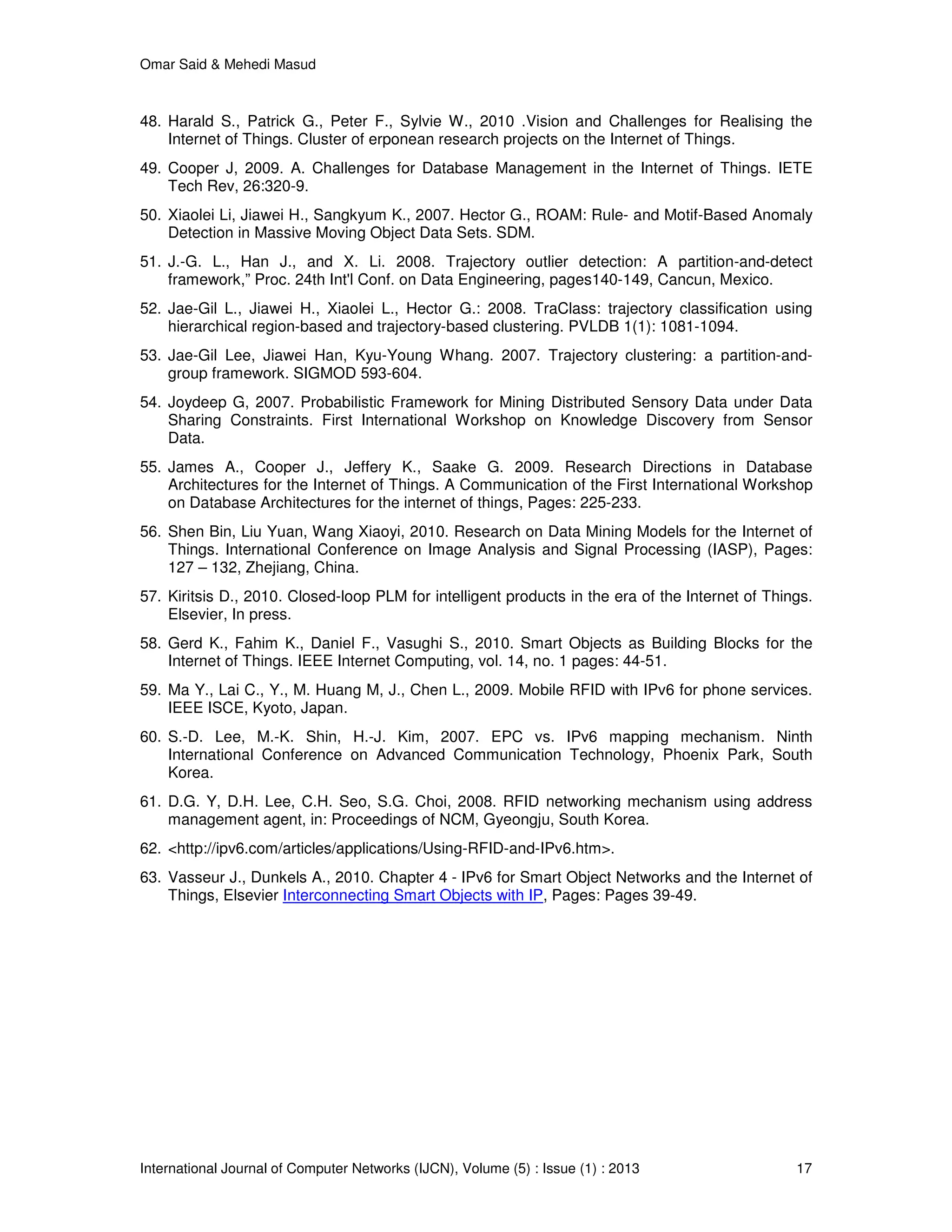The paper presents a comprehensive survey on the Internet of Things (IoT), detailing its history, architectures, research challenges, and future vision. It discusses the evolution of IoT from connecting computers to linking everyday objects, presents various proposed architectures (3-layer and 5-layer), and highlights challenges related to information gathering, security, privacy, and communication. The authors conclude with recommendations and acknowledge ongoing research in the area, emphasizing the potential of IoT in various applications such as marketing, healthcare, and smart environments.
![Omar Said & Mehedi Masud
International Journal of Computer Networks (IJCN), Volume (5) : Issue (1) : 2013 1
Towards Internet of Things: Survey and Future Vision
Omar Said o.saeed@tu.edu.sa
IT/ College of Computers and Information Technology
Taif University
Taif, Saudi Arabia.
Mehedi Masud mmasud@tu.edu.sa
CS/ College of Computers and Information Technology
Taif University
Taif, Saudi Arabia.
Abstract
Internet of things is a promising research due to its importance in many commerce, industry, and
education applications. Recently, new applications and research challenges in numerous areas of
Internet of things are fired. In this paper, we discuss the history of Internet of things, different
proposed architectures of Internet of things, research challenges and open problems related to
the Internet of things. We also introduce the concept of Internet of things database and discuss
about the future vision of Internet of things. These are the manuscript preparation guidelines used
as a standard template for all journal submissions. Author must follow these instructions while
preparing/modifying these guidelines.
Keywords: Internet of Things, RFID, TCP/IP, Web Applications.
1. INTRODUCTION
Recently, the concept of the Internet as a set of connected computer devices is changed to a set
of connected surrounding things of human’s living space, such as home appliances, machines,
transportation, business storage, and goods etc. The number of things in the living space is larger
than the number of world population. Research is going on how to make these things to
communicate with each other like computer devices communicate through Internet. The
communication among these things is referred as Internet of Things (IoT). Till now, there is no
specific definition or standard architecture of IoT. Some researchers define the IoT as a new
model that contains all of wireless communication technologies such as wireless sensor
networks, mobile networks, and actuators. Each element of IoT is called a thing and should have
a unique address. Things communicate using the Radio-Frequency Identification (RFID)
technology and work in harmony to reach a common goal. In addition, the IoT should contain a
strategy to determine its users and their privileges and restrictions. The US National Intelligence
council has stated that by 2025 the IoT will connect everything in our life [1]. For this target new
architectures are proposed and more research challenges are opened. Authors in [1] highlight
some research challenges. Despite new architectures are proposed in the recent years, however,
the future vision of IoT is still unclear. Considering the research challenges and future vision of
IoT, in this paper we present a detail survey. At the end of the paper, we also present our
recommendations.
The rest of the paper proceeds as follows. Section 2 demonstrates the history of IoT. Section 3
introduces the currently proposed IoT architectures. Section 4 introduces the IoT research
challenges and open problems. Section 5 presents the IoT database. Section 6 discusses future
vision of IoT. Section 7, demonstrates the comparison between our survey and other surveys.
Finally, the paper concludes in Section 8.](https://image.slidesharecdn.com/ijcn-265-160223182912/75/Towards-Internet-of-Things-Survey-and-Future-Vision-1-2048.jpg)
![Omar Said & Mehedi Masud
International Journal of Computer Networks (IJCN), Volume (5) : Issue (1) : 2013 2
2. THE IOT HISTORY
2.1 IoT Definition
Internet has become more prevalent in our lives in a shorter time period than any other
technology in the history. It revolutionized the communicate way of people. Currently, the Internet
involves the process of connecting machines, equipment, software, and things in our
surroundings. This connection will be through the use of the unique Internet protocol address that
permits things for communicating to each other without human intervention. This new scenario is
called IoT [2]. The term IOT is formalized by MIT Auto-ID center at [3]. Till now there is no
accepted or standard definition for IoT.
2.2 The IoT Applications
There can be many applications of IoT. The famous IoT application is in marketing. We know that
a market contains many goods and electrical machines. By using IoT, an item can automatically
contact its provider and inform its situation in case of stock decreasing [4]. The cooperation
between the traffic lights and the sensors for environment pollution is another example that uses
the IoT technology [1]. This cooperation using IoT may provide a life with new advantages such
as the normal distribution of cars in the roads and the adaptive time for each sign to be on or off
[5]. There is also a range of IoT applications in France. For example, the use of glass containers
equipped with ultrasonic sensors that send information about its level of filling [1]. When the level
reaches to three-quarters of the container, the collection, loading and unloading processes are
started automatically. In the United States, there are many applications exist such as garbage
cans that are provided with sensors. When the garbage reaches a certain weight or level, warning
is sent to the municipality in order to send the garbage cars, which leads to reduce the taxes on
homeowners and reduce the cost and the time of communication process [1]. Also, IoT and RFID
technology are used to recycle information about automotives factories in china [6]. In addition,
there are some projects, which are still under progress, e.g., e-learning, healthcare, smart
environment (home, office, plant), and industrial fields [1, 7, 8].
Regarding the IoT and Internet applications, it is clear that the IoT applications and the Internet
applications are similar. Based on the ontology, both applications have a common character.
There are some close relations such as Hypertext and text, XML and electronic tag, and
Standardization and free restrictions. The ascendancy of IoT comes from product information and
Internet. The IoT is tangible restriction to the product information. The product information must
be written on an electronic tag, with fixed format and standardized and general words. Internet of
Things can be considered as a special application of Semantic Web. It tries to appreciate the
mentally processing and sharing the product information based on the Semantic Web platform [9,
10].
3. THE IOT ARCHITECTURES
Recently, there are two IoT architectures are suggested (i) 3–layer architecture and (ii) 5-layer
architecture, and other special purpose architectures, respectively [11, 12, 13, 14]. In the
following, we present these architectures.
3.1 The 3-Layer architecture
Beginning of the IoT, the accepted architecture was the 3-layer architecture. It consists of three
layers which are called perception, network, and application. The purpose of perception layer is to
identify each thing in the IoT system. This is done by gathering information about each object.
This layer contains RFID tags, sensors, cameras, etc. The second layer is the network layer. The
network layer is the core of the IoT. It transmits the information gathered by the perception layer.
It contains the software and hardware instrumentations of internet network in addition to the
management and information centers. The third layer is the application layer. The application
layer’s target is to converge between the IoT social needs and industrial technology (i.e. it can be
considered as the middle tier between the industry technologies and how it can be controlled to
cover the human needs) [11], see Fig. 1.](https://image.slidesharecdn.com/ijcn-265-160223182912/75/Towards-Internet-of-Things-Survey-and-Future-Vision-2-2048.jpg)
![Omar Said & Mehedi Masud
International Journal of Computer Networks (IJCN), Volume (5) : Issue (1) : 2013 3
FIGURE 1: The IoT 3-Layer Architecture [11].
3.2 The 5-Layer Architecture
The 3-layer architecture became not sufficient due to the expected IoT development. Therefore,
5-layer architecture is proposed. The first layer is called business. The purpose of this layer is to
define the IOT applications charge and management. Also, it is responsible about the user’s
privacy and all research related to IOT applications. The second layer is called application. The
target of this layer is determining the types of applications, which will be used in the IoT. Also, it
develops the IOT applications to be more intelligence, authenticated, and safe. The third layer is
called processing. Its responsibility is to handle the information gathered by perception layer. The
handling process contains two main topics; storing and analyzing. The target of this layer is
extremely hard due to the huge gathered information about system things. So, it uses some
techniques such as database software, cloud computing, ubiquitous computing, and intelligent
processing in information processing and storing. The fourth layer is called transport. It seems
like the network layer in the 3-layer architecture. It transmits and receives the information from the
perception layer to the processing layer and via versa. It contains many technologies such as
infrared, Wi-Fi, and Bluetooth. Also, the target of this layer is to address each thing in the system
using IPV6. The fifth layer is called perception. The target of this layer is to define the physical
meaning of each thing in the IoT system such as locations and temperatures. It also gathers the
information about each object in the system and transforms this data to signals. In addition, it
contains the technologies that are used in the IoT such as the RFID and the GPRS [11]. Fig. 2
presents the 5-Layer architecture.
FIGURE 2: The IoT 5-Layer Architecture [11].](https://image.slidesharecdn.com/ijcn-265-160223182912/75/Towards-Internet-of-Things-Survey-and-Future-Vision-3-2048.jpg)
![Omar Said & Mehedi Masud
International Journal of Computer Networks (IJCN), Volume (5) : Issue (1) : 2013 4
3.3 Special Purpose Architectures
There are some special purpose IoT architectures. The first architecture [15] is related to media-
aware traffic security architecture. This architecture is based on the given traffic classification to
enable various multimedia services being available anywhere and anytime. The second
architecture [16] is new clock synchronization architecture of network for IoT. This clock
synchronization architecture of IoT is the key technology to resolve the problems, which are
released due to manage the IoT nodes effectively and to ensure high clock synchronization
precision. It includes three levels: adaptation level, organization level and region level. The
adaptation level architecture is to resolve the problem about the adaptability of IoT; the
organization level architecture is to organize and manage of the clock synchronization system;
the region level architecture is to ensure clock synchronization accuracy and security. The third
architecture [17] is for trusted security systems. This architecture is based on cholars' researches
and combined with the security requirements and characteristics of IoT. This architecture also
includes trusted safety management system, security gateway, unified service platforms of IoT,
security infrastructure, and unified information exchange platform. The fourth architecture [18] is
mankind neural system. This architecture introduces two aspects: Unit IoT and Ubiquitous IoT.
The Unite IoT focus on special targets (provides solutions for special applications), and its
infrastructure is a man-like nervous system. The Ubiquitous IoT focus on the collection of multiple
unites of IoTs with ubiquitous views (assemble the special organization to be manageable by one
powerful application). Also, there are some special purpose architectures [19, 20, 21] which
cannot be considered a standard architecture.
4. IOT CHALLENGES AND OPEN PROBLEMS
There are numerous challenges in the IoT which are still under research. The IoT challenges and
open problems are raised due to two main reasons. These reasons for mass gathering
information for each thing in the IoT system and the communication among system hardware, see
Fig. 3.
FIGURE 3: IoT Challenges and Problems.](https://image.slidesharecdn.com/ijcn-265-160223182912/75/Towards-Internet-of-Things-Survey-and-Future-Vision-4-2048.jpg)
![Omar Said & Mehedi Masud
International Journal of Computer Networks (IJCN), Volume (5) : Issue (1) : 2013 5
4.1 Information Gathering Problems
These problems can be divided to two main classes. The first one is related to the massive
information that is gathered by RFID about huge number of things which are found at IoT system.
The second is the security and the privacy of information due to wireless transmission media.
Massive gathered information: The IoT systems should have millions if not billions of objects.
Each object should radiate information to express about itself. This information should be
gathered. The quantity of gathered information is massive due to the huge number of IoT objects.
So, there are several problems which are raised due to a lot of gathered information. These
problems are transmission, storing, and processing. Transmission problem means that it is
required to transmit all of things data in real time and this is not a guaranteed issue [22, 23]. This
is because of the bandwidth issue, which is required to transmit this information, may be not
available. It is well known that the information travels in a trip starting from the things and ends to
its control web application. This trip may contain more bandwidth bottlenecks which mean that a
required bandwidth is mostly not available. The problem of data storing is raised due to the
quantity of media required to store and backup this information. The processing operation means
that the things information should be handled by IoT web applications to determine the control
actions for each thing. This handling process should be done in a real time mode [24, 25].
Security and privacy: It’s well known that the data is transmitted between IoT objects inside a
wireless medium. So, the security and privacy issues are very important and should be
discussed. Regarding the security problem, there are numerous causes to make the IoT
information in danger. These causes are physical attack, wireless information attack, and low
self-defense. The physical attack means that the hacker may tamper with the IoT devices due to
presence of these devices alone most of the time. Hence, anyone can hack it physically. The
wireless information attack means that the hacker can acquire the information from the medium
before it is received by the destination and there are more researches in this topic [26, 27, 28,
29]. The low self defense means that most of IoT devices didn’t have an ability to accept security
package(s) for partially saving [30, 31, 32].
The privacy is an important issue in civilized countries. It means that the information provider is
only able to infer by observing the use of the system related to each system client (at least,
inference should be very hard to conduct). The data collection, handling, and mining are
accomplished in the IoT systems in completely different form that we know. This is because there
are more situations that may occur in the IoT system such as home resources control system. So,
to guarantee the privacy of things personal information, we should make sure of three main items;
(1) who collects the personal data, (2) how these data are collected, and (3) the time of collection
process. Furthermore, the personal data that are collected should be used by authorized the
person, stored in an authorized server, and accessed by authorized clients [33, 34, 35].
The security and privacy needs three main requirements: resilience to attack, data authentication,
and client privacy. Also, some questions related to human rights and constitutional framework are
raised such as if new international laws are needed, if legislation is envisaged [1, 36].
4.2 Things Communication Problems
The problem related to the communication between IoT things components, is divided into two
classes. The first is addressing of things problem and the second is RFID problems in reading,
writing, and transmission of objects information. In the following, we discuss the things
communication problems.
Billions of IoT things: When we think in communication process among a large number of things,
we observe a big problem due to many issues. Sample of these issues are: what is the hardware,
which is required for communicating this massive number of things? What is the ideal addressing
technique (protocol) for each thing in the resulted system? If the answer is IPV6, another question
will be raised; if IPV6 is suitable for the IoT future? The compatibility between a huge number of
required hardware, which consist the IoT systems, can be considered as a communication factor](https://image.slidesharecdn.com/ijcn-265-160223182912/75/Towards-Internet-of-Things-Survey-and-Future-Vision-5-2048.jpg)
![Omar Said & Mehedi Masud
International Journal of Computer Networks (IJCN), Volume (5) : Issue (1) : 2013 6
or not? and others. There are many attempts that have emerged to answer these issues [37, 38,
39, 40, 41, 42, 43], but most of these researches are theoretical and lack in practice.
Furthermore, they did not specify the IoT future vision and parameters. The problem of the tools,
which are proposed so far to build an integrated IoT system, is incomplete and lacking in
standard. Another trial for accessing the information instead of using hardware communications
(RFID) is presented in [44]. This trail uses the computer vision and image processing techniques
to access the thing information and suffers from delay due to the time consumption in object
image handling process (see subsection entitled real time object detection).
IoT and TCP challenge: The IoT infrastructure is similar to the Internet backbone. So, the data
transmission will use TCP or UDP protocols as a transmission protocol. The UDP is not reliable
protocol and this is opposite of our target. Hence, TCP should be selected to act as a transport
layer for IoT systems. The TCP has more challenges related to the IoT systems such as
connection setup, congestion control, and data buffering. The connection setup may not be
considered in most cases in the IoT systems due to the need to transmit small amount of data
between objects. In addition, the communication resources in IoT are mostly sensors, RFID tags,
and PDAs which cannot handle the data required for connection setup. The congestion control is
a challenge in the wireless medium which is the same medium of IoT systems. Also, in case of
small transmitted information between IoT objects, the congestion control data is not required.
The data buffering in TCP is required at the source for retransmission process and destination for
ordering process. The data buffering processes are costly for the battery-less devices such as
RFID tags. So, the conclusion is UDP is not suitable and TCP has more challenges and in most
IoT cases is not required. Many researchers studied the characteristics and actions of transmitted
information inside IoT objects such as WSN and RFID systems [22, 23, 24].
Real time objects detection: When we concentrate in IoT system, we find two ambiguous queries;
how we can define each thing and how we can acquire its information. It is natural if we answer
by using the RFID, the EPC, or the UID technologies. But, these technologies have several
problems such as radiation, privacy, violation, and inconvenience of information updating. In
addition, it is not easy to define all of these technologies with the entire world things shortly.
There are many researches tried to solve these problems such as [45], [46]. Authors in [44]
introduce another idea which changes the concept of using above technologies for things
definition. Instead of using the RFID, the EPC, or the UID, we can use the computer vision and
image processing techniques such that each object can extract other objects by vision. Also, this
idea faces another challenge, namely the real time handling. The real time handling means that
the relation between the IoT system objects, which contains three main steps; seeing, analysis,
and information extraction should be accomplished in real time mode.
IoT QoS: There are many researches in the internet QoS such as [47, 48]. But these scenarios
are not suitable for the IoT systems. This is because the QoS researches considered a localized
area in the IoT such as Wireless Sensor Network (WSN) and not for other areas such as the
RFID. The research of QoS may be applied on the IoT systems but this can be considered as a
short term solution. In addition, the QoS results are executed on the M2M communication. But, in
case of IoT, there are different paradigms due to the mixture of IoT objects each one has a
different characteristics and behavior [1, 2].
4.3 Core Challenge
The most important factor in the IoT is to build a standard and universal architecture. So, now we
try to construct this architecture based on our daily live. The attempt, which is introduced in [18],
is much closed idea to our trial. This attempt is limited. The limitation of this architecture comes
from the consideration that the entire IoT systems have the same features and layers. This is not
true in most cases. In IoT infrastructure, there are many systems with different targets,
applications, and features. Hence, we should expand the architecture, which is introduced in [18],](https://image.slidesharecdn.com/ijcn-265-160223182912/75/Towards-Internet-of-Things-Survey-and-Future-Vision-6-2048.jpg)
![Omar Said & Mehedi Masud
International Journal of Computer Networks (IJCN), Volume (5) : Issue (1) : 2013 7
to be the most common one that will communicate these different systems (work in this
architecture in progress).
5. IOT DATABASE
Internet of Things system produces mass information. The format of RFID contains three parts
EPC which represents the unique identifier read by an RFID reader; location is the place where
the reader is found, and time of reading process. It is well known that RFID raw needs
approximately 18 bytes. If we took a supermarket as an example, there are about 700,000 RFID
tags. If the supermarket has readers that scan the items every second, about 12.6 GB RFID data
will be produced per second, and the data will reach 544TB per day. So, it is necessary to find
effective methods for storing, filtering and modifying RFID raw data. The Internet of Things
gathered information can be classified into numerous types: RFID data stream, address/unique
identifiers, descriptive data, positional data, environment data and sensor network data etc. [49].
It is a great challenge to manage the Internet of Things information. Many trials have appeared to
suggest models for dealing with this type of intensive database. Reference [50] provides a new
model called ROAM and used for variance detection in moving objects. Reference [51] developed
a novel partition-and-detect model for faraway trajectory detection of moving object. Reference
[52] also put forward a new method called TraClass using trajectory-based clustering and
hierarchical region-based. Reference [53] introduced a new model in trajectory clustering of
moving object which is called a partition-and-group. Reference [54] proposed a general model to
supervise learning under the conditions of power, computational, and memory limitations. The
special characteristics of IoT such as mass data, distributed data, time-related data, and
heterogeneous environment bring several problems to centralized data mining architecture [55].
The last trial [56] suggested four different models. The first model, called multi-layer data mining
model for IoT, which consists of four layers each one accomplishes some functions. These layers
are data management layer, event processing layer, data mining service layer, and data
collection layer, and each layer has many functions. The second model is called distributed data
mining model for IoT. In this model, there is a core for entire data mining system which is called
the global control node. It determines the data mining algorithm and the data sets for mining, and
then search about the sub-nodes containing these data sets. Hence, these sub-nodes receive the
raw data from various smart things. These information is filtered, abstracted, and compressed,
and then is saved in the local data warehouse. The third model is called grid based data mining
model for IoT. IoT objects should intelligent, context-awareness, and long-range operable.
Therefore smart IoT objects are considered as a kind of resources for grid computing. Thus,
using the data mining services of grid to implement the data mining operations for IoT is the core
of this model idea. The fourth model is called data mining model for IoT from multi-technology
integration perspective. In this model, the context-awareness provides the IoT system with data
individually or from smart objects. IPV6 protocol is used in objects addressing. There are different
ubiquitous ways are used for accessing the future Internet such as, sensor devices, RFID,
WiMAX, etc. Credibility and controllability of data transmission are adapted by a trusted control
plane. So, data mining tools and algorithms are carried out, and different service-oriented
applications such as intelligent transportation, intelligent logistics accepts the gained knowledge.
5.1 Suggested IoT Database Architecture
We propose a multilayer data mining model for the proposed system based on [56]. The model
consists of six layers: IoT layer, data collection layer, data warehousing layer, event processing
layer, data mining service layer, and application layer. Table 1 describes each layer’s functions
while Fig. 4 presents a general view of the data model. Table 1demonstrates Functions of the
Data Model Layers.](https://image.slidesharecdn.com/ijcn-265-160223182912/75/Towards-Internet-of-Things-Survey-and-Future-Vision-7-2048.jpg)
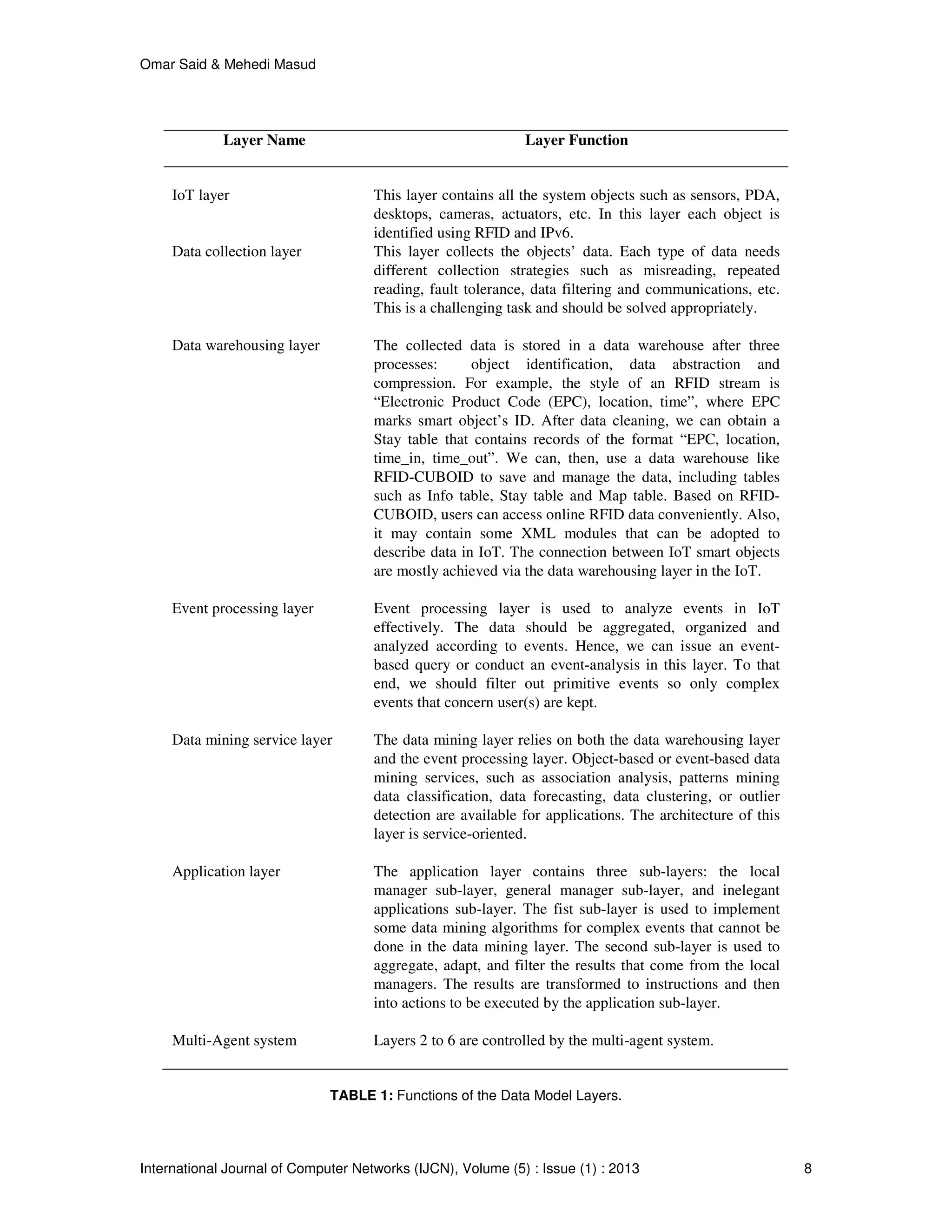

![Omar Said & Mehedi Masud
International Journal of Computer Networks (IJCN), Volume (5) : Issue (1) : 2013 10
6. IOT DISCUSSION AND FUTURE VISION
In this section we discuss some issues regarding the IoT. Before we demonstrate our vision in
IoT we first give an example: Consider a scenario where a person lives in a smart city. When the
person wakes up from sleep, there is a set of events occurs between his waking up until he
returns to his home (i.e. work hours events). First, he goes to the bathroom. The bathroom door is
automatically opened. Then the faucet water is opened for adaptive interval time. As this person
comes in the front of the apartment door, it is opened. While the person moves to the elevator, its
door will be opened and the elevator is adapted to stop at the person desired level. These smart
actions from the things that will be used by this person will continue until he reaches his work. If
he wants to know information about something within the trip, he can easily access it by other
things which are closed to the target one. This scenario is accomplished by communicating the
system things (bathroom door, faucet water, apartment door, elevator, etc.) to be one network
using IoT technology (smart application). This network makes the objects behavior like a human.
From above example, it’s clear that our future vision of IoT is to make everything like an
autonomous robot. This is a truth, which should be reached, but nowadays, this is not easy to
accomplish. Science, there are more things which are passive. In addition, to transform each
thing in our live, even it is active, from human control to full smartness is extremely expensive [57,
58]. Without complexity, the full smartness of a thing can be defined as the ability to make this
thing behavior like a human behavior using software and hardware. Let us take a thing such as
smart board and imagine that we would like to transform it into full smartness. The smart board
can be considered as an active thing. This smart board should sense a human (student or
professor) desires in addition to its around hardware tools such as data show and cameras. To
accomplish these two simple characteristics, we need camera, image processing technique,
processor, actuator, and intelligent program to adapt the smart board motion. All of these
components are needed for transforming the active thing from static situation (i.e., with human
controlled) to smartness.
From our point of view, in the near future we will find that most of these things in our
range of living will be smart. In this case, we will find ourselves facing an amazing programming
challenge to achieve the ultimate goal of IoT, see Fig. 5.
FIGURE 5: Live Cycle of Thing To Be in The IoT System.](https://image.slidesharecdn.com/ijcn-265-160223182912/75/Towards-Internet-of-Things-Survey-and-Future-Vision-10-2048.jpg)
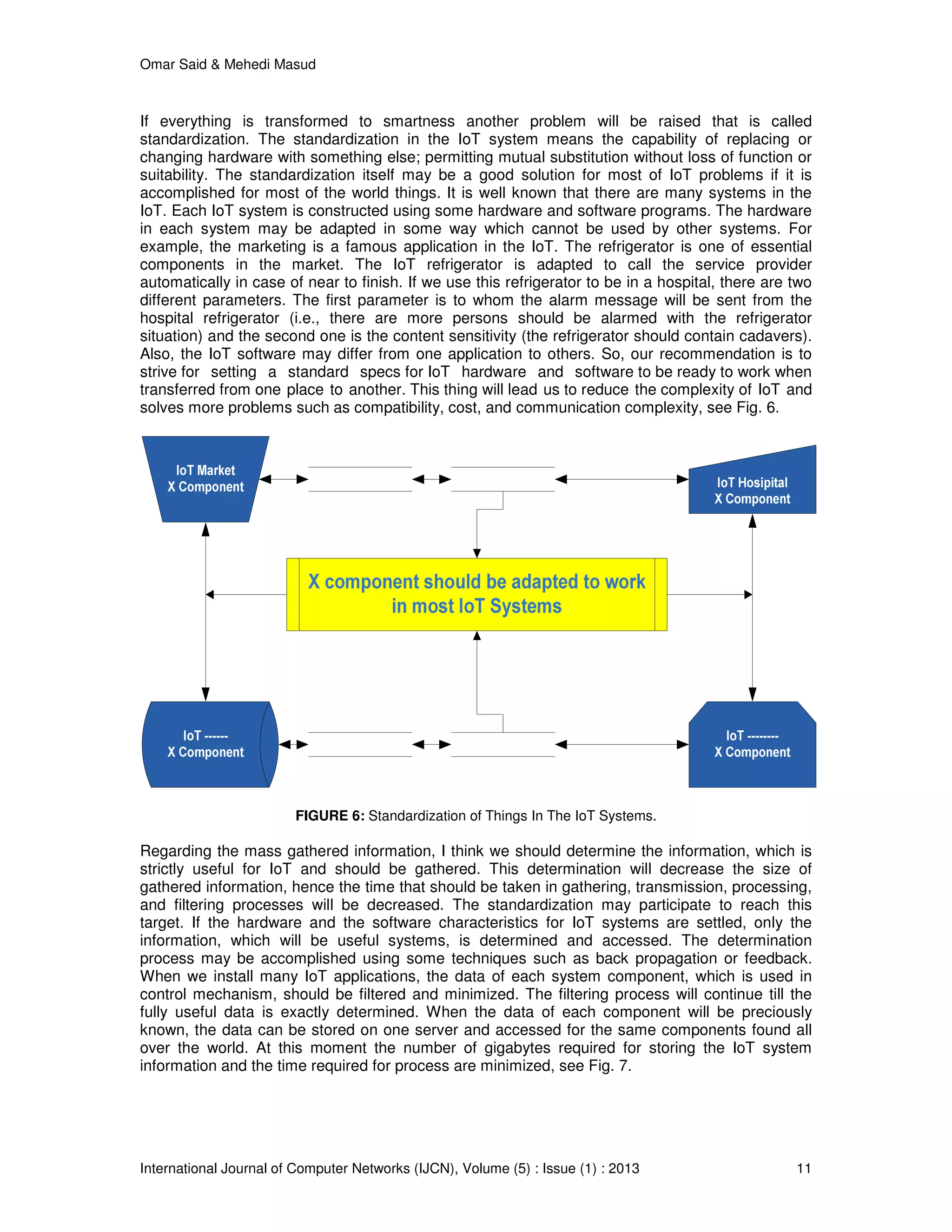

![Omar Said & Mehedi Masud
International Journal of Computer Networks (IJCN), Volume (5) : Issue (1) : 2013 13
IPv6 networks has been researched and techniques to add RFID identifiers and IPv6 addresses
have been demonstrated in [59]. For example, the 64 bits are used to address the gateway
between the internet and RFID system, and the other 64 bits are used to as an identifier of the
IPv6 address to report the RFID tag identifier [60]. This trial cannot be used in case of 96 bits
RFID identifier as found at EPCglobal. This problem is solved by deploying an agent to maps the
RFID identifier into 64 bits to be used as an ID of IPV6 address. This mapping should be kept by
this agent [61]. Another trial is introduced in [RFID URL]. This trial illustrates that IPV6 packet
contains the body and the header of RFID message. There is another important issue regarding
IPV6 and IoT addressing that is called mobility. We still in need to a technique describe the
mobility issue in the IoT systems with guarantee of scalability and reliability with IoT
heterogeneous environment. Also, How to obtain the IoT system addresses is an important issue
should be adapted. In the IoT, the Object Name Service (ONS) should be able to combine the
RFID tag identifier with the explanation of its object, and vice versa. The reversion process
requires special techniques such as Object Code Mapping Service (OCMS) [62, 63].
FIGURE 8: The IoT Should Be One System Contains Number of Related Sub-Systems.
7. OUR SURVEY vs. OTHER SURVEYS
The difference between our survey and other surveys [1], [23] is demonstrated below in Table 2.
There are many parameters which are discussed in our survey and neglected in others such as
IoT database and IoT core challenges. Also, there are some parameters which are extremely
discussed in our survey and briefly discussed in others like IoT architectures.
Criteria Our Survey
First Survey
[1]
Second Survey [23]
IoT Application Briefly Discussed
Extremely
Described
Extremely Described
IoT Architecture Extremely Discussed Not Found Not Found
IoT Database Discussed Not Found Not Found
IoT Challenges Discussed Described Extremely Described
IoT Future Vision Extremely Discussed Not Found Briefly Discussed
IoT Open Issues Described Described Not Found
TABLE 2: The Comparison Between IoT Surveys.](https://image.slidesharecdn.com/ijcn-265-160223182912/75/Towards-Internet-of-Things-Survey-and-Future-Vision-13-2048.jpg)
